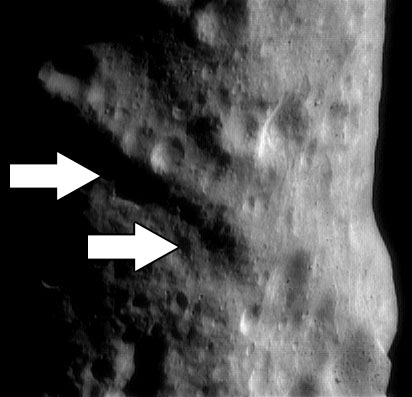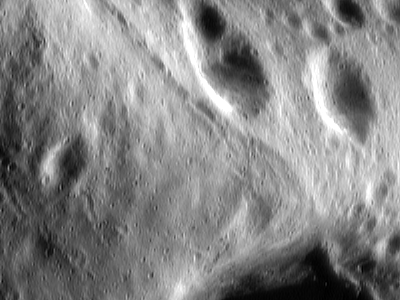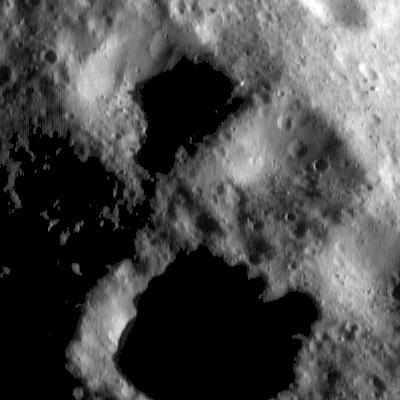Intermediate Scale

|
| A close up view of a wide groove on the West side of Eros. (130230097) |
A closer look at the surface of Eros allows more features to become visible. With
the introduction of higher resolution images from the NEAR spacecraft, prominent
groove and ridge systems started to appear. In addition, thousands of small and
medium size craters can be seen blanketing the entire surface.
Believed to have been formed from the stress of the formation of Eros, grooves
can be seen clearly in many orbital images around Himeros and on the eastern
end of Eros. The term groove is given to long, narrow channels on the surface.
In some cases these features can be referred to as troughs, but for the most
part, the terms are synonymous. Grooves on Eros are generally 75-100 meters
wide and can be as long as 2 km. An example of one such groove can be seen in
the image to the right. This is the Calisto Fossae groove. This wider than average
groove (500-700 am) is made up of two parallel grooves with a prominent ridge
that stretches for several kilometers and maintains an average depth of around
a hundred meters. Grooves can also be found in large concentration in the region
northwest of Himeros. The largest groove in this region can be found here inside
the Himeros along the Western wall. This groove is 100 meters wide and stretches
2 km in a backward "C" shape (Prockter et al. 2002;
Cheng et al. 2002).

|
 |
(Top) A northern view of Rahe Dorsum
- 129892867 (Bottom) Formation of a shallow angle fault
|
Located at the end of the groove in Himeros is one end of Rahe Dorsum ridge system.
Spanning over 18 km is the ridge system, Rahe Dorsum, which starts inside Himeros
then wraps around the north side of Eros to the eastern side of the Psyche crater.
This ridge system generally has a width of about 300 meters and maintains a height
of only a few tens of meters. The ridge is believed to be formed due to a shallow
angle fault in which one side rises to form a hanging wall. This is apparent on
the asteroid because one side of the ridge is "flat" while the other side is very
steep (as seen in lower illustration to the left). It has been suggested that
Rahe Dorsum was formed as a result of the last major impact event, Shoemaker crater.
This is believed to be due to the fact that Rahe Dorsum overlaps Himeros, and
grooves that crosscut the ridge on the western side of Eros also overlap part
of Psyche's wall. This conclusion is uncertain because different parts could have
formed at different times.
Coincidence or not, both the Rahe Dorsum ridge system and the Calisto Fassae
groove exist on the same plane. This could be caused by the asteroid's bending
after a large impact or a near miss with another large body. In this case the
surface on the concave side would be pressed together (forming ridges), and
the concave side would be stretched (forming grooves). The only problem with
the theory are the two features' relative ages. Calisto Fossae appears worn
and has several large impact craters that suggests a relatively old age. On
the other hand, Rahe Dorsum is a prominent feature with no craters larger than
200 meters suggesting that it is a fairly new feature in comparison to other
features on the surface of Eros, including Calisto Fossae. One answer to the
issue is that Rahe Dorsum is still forming and growing from additional impacts.
For example, after a large impact, like the one that formed Shoemaker crater,
the thrust fault that Rahe Dorsum is on reactivated. When this happened, the
ridge was "rebuilt" giving an impression of a young age (Prockter
et al. 2002; Thomas 2002).

|
| Square Craters (132151540) |
In addition to grooves and ridges, craters also fit in the category of intermediate
scale features. Scattered over the surface of Eros is a combination of small and
medium sized craters. Currently there are 44 medium size craters that range from
1 to 5 km in diameter along with thousands of smaller craters that are less than
1 km in diameter. Throughout the years crater counts have been used to figure
out relative age on the Moon and other terrestrial bodies. In this method, craters
are counted in a region and compared to another region. The results can give a
relative age. Unfortunately this process is not as reliable here as on the Moon
or any other large body because Eros is so small that the sample areas would also
be too small. If one section of Eros had 20 craters and another had 17, there
is not a significant difference to say that the second area was younger. This
method also assumes that one spot on the surface has the same odds as another
in being impacted, but due to Eros' shape and spin axis, this may not be true.
In addition steep areas along the crater walls show evidence of resurfacing. Resurfacing
may cause craters to be wiped out and, therefore, change the crater count. Overall
in large samples, like the ones taken on the moon, this process would be more
reliable, but the practice on a small body of an asteroid, like Eros, this process
of measuring relative age is defective (Veverka 2001;
Thomas 2002).



